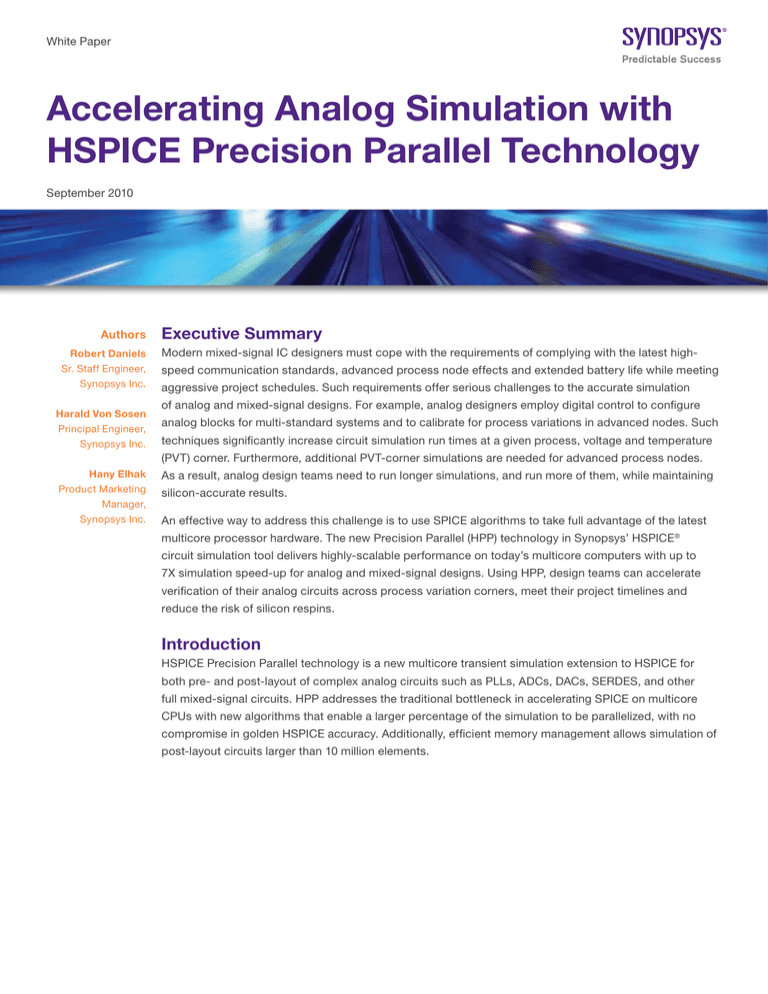
White Paper
Accelerating Analog Simulation with
HSPICE Precision Parallel Technology
September 2010
Authors
Robert Daniels
Sr. Staff Engineer,
Synopsys Inc.
Harald Von Sosen
Principal Engineer,
Synopsys Inc.
Executive Summary
Modern mixed-signal IC designers must cope with the requirements of complying with the latest highspeed communication standards, advanced process node effects and extended battery life while meeting
aggressive project schedules. Such requirements offer serious challenges to the accurate simulation
of analog and mixed-signal designs. For example, analog designers employ digital control to configure
analog blocks for multi-standard systems and to calibrate for process variations in advanced nodes. Such
techniques significantly increase circuit simulation run times at a given process, voltage and temperature
(PVT) corner. Furthermore, additional PVT-corner simulations are needed for advanced process nodes.
Hany Elhak
Product Marketing
Manager,
Synopsys Inc.
As a result, analog design teams need to run longer simulations, and run more of them, while maintaining
silicon-accurate results.
An effective way to address this challenge is to use SPICE algorithms to take full advantage of the latest
multicore processor hardware. The new Precision Parallel (HPP) technology in Synopsys’ HSPICE®
circuit simulation tool delivers highly-scalable performance on today’s multicore computers with up to
7X simulation speed-up for analog and mixed-signal designs. Using HPP, design teams can accelerate
verification of their analog circuits across process variation corners, meet their project timelines and
reduce the risk of silicon respins.
Introduction
HSPICE Precision Parallel technology is a new multicore transient simulation extension to HSPICE for
both pre- and post-layout of complex analog circuits such as PLLs, ADCs, DACs, SERDES, and other
full mixed-signal circuits. HPP addresses the traditional bottleneck in accelerating SPICE on multicore
CPUs with new algorithms that enable a larger percentage of the simulation to be parallelized, with no
compromise in golden HSPICE accuracy. Additionally, efficient memory management allows simulation of
post-layout circuits larger than 10 million elements.
Challenges in Accelerating SPICE
A typical SPICE simulation analyzes the circuit on a large number of time steps. Each time step consists of
multiple iterations, each of which can be broken down into two major tasks:
``
Evaluating the devices in the circuit and loading them into a matrix
``
Solving the matrix to calculate voltage and current at each node
The iterations continue until the circuit converges, then the simulator moves to the next time step and repeats
the same process.
The percentage of simulation time spent in evaluating the devices and solving the matrix is dependent on
circuit type. The key to accelerating SPICE on a multicore CPU is to be able to parallelize as much of each
individual task as possible without sacrificing accuracy.
Device evaluation is the dominant activity for small pre-layout circuits. This may take up to 75% of the
simulation time and scales linearly with circuit size. Traditional SPICE simulators distribute this task on multiple
CPUs, achieving a modest level of parallelization. Leaving more than a third of the simulation in sequential
tasks, one can only expect 2-3X speedup using 8-core machines, as Amdahl’s law predicts. Figure 1 depicts
how performance plateaus when multi-threading a hypothetical circuit on 2-, 4- and 8-core machines.
Scalability is even worse on large post-layout circuits where device evaluation represents less than half the
simulation time. Solving the matrix can consume more than 50% of the simulation time for large post-layout
circuits. Significant scaling can be achieved by parallelizing this task, however, solving a sparse matrix (the
typical matrix form for electronic circuits), involves a great deal of sequential activities. Traditional SPICE
simulators scale poorly. Even with 90% efficiency, Amdahl’s law predicts a theoretical speedup of 5X on
8 cores, as shown in Figure 1. The scaling is further limited by the speed of data as it moves between
processors and memory. The actual speed-up can be less than 3X on 8 cores.
To obtain highly-scalable computations, the parallel efficiency of the underlying code must be very close to
100%, as shown in Figure 1. Another simulation challenge is that the order of data processing is not cacheefficient. Cache efficiency is important for multicore performance because processors compete for cache and
memory access.
8
Speed-up (X)
7
6
98% efficiency
5
4
98% parallel efficiency
Traditional parallel SPICE
Device eval (large circuit)
Device eval (small circuit)
90% efficiency
3
2
1
0
2
4
Number of cores
6
8
Figure 1: Theoretical limits of parallel SPICE simulation (Amdahl’s Law)
Accelerating Analog Simulation with HSPICE Precision Parallel Technology
2
HSPICE Precision Parallel Technology
HPP applies several new algorithms to the transient analysis problem. This includes improving single-thread
computation, implementing a highly-scalable approach to take full advantage of multicore machines, and,
finally, optimizing the memory management with a compact memory footprint and efficient cache utilization.
These improvements have been implemented in HPP while maintaining full accuracy.
Single-Core Speed
Modern analog circuits consist of components that operate at different time constants. For example, a
PLL consists of a voltage-controlled oscillator and divider operating at a high frequency, while other circuit
components such as the phase detector, filter and digital control circuitry operate at much lower speed. The
adaptive sub-matrix algorithm in HPP technology manipulates the matrix in such a way that slower parts of
the circuit can be solved in fewer iterations than the faster ones, significantly improving the overall simulation
speed. Figure 2 shows the average HSPICE speed improvements over the past three years. The HPP
Speed-up (X)
technology in the 2010.12 release delivers an average 40% speed-up over the previous release.
Single-core speed-up
6
5
4
3
2
1
0
HPP
2007
2009
2008
2010
Year
Figure 2: Single-core speed improvement in HSPICE
Multicore Scaling
HPP technology uses an adaptive sub-matrix algorithm--a highly scalable algorithm that divides the matrix
solving stage into smaller tasks that can be efficiently performed on multiple CPU cores. In addition, it
parallelizes other small tasks such as output and time step control to achieve parallelization efficiency close
to 100%. The result is up to 7X scaling on 8 cores, a significant improvement over the previous release. Figure
3 shows HSPICE multicore scaling on representative analog/mixed-signal circuits such as Sigma-Delta data
Run Time (Hours)
converters and PLLs.
60
50
40
30
20
10
0
6.8X
4.4X
7.5X
6.2X
5.3X
DLL
8-bit
DAC
8 cores
6.7X
Sigma- DC-DC SigmaDelta
Delta 2
1 core
PLL
AMS Circuits
Figure 3: HSPICE multicore scaling on representative analog/mixed-signal circuits
Accelerating Analog Simulation with HSPICE Precision Parallel Technology
3
Cache Efficiency and Memory Bus
Even with almost 100% parallelized code, the actual scaling achieved will be limited by cache misses and the
finite time required in moving data between cache and main memory. The degree to which cache misses and
data movement affect the overall scaling depends on the machine parameters, e.g., cache size, memory bus
speed and the efficiency of the code (e.g., localization and minimization of data). HSPICE uses very efficient
localization of data in blocks that are comparable in size to the highest-level cache. The variable controlled by
the user is the multicore architecture on which HPP is run. Generally, the larger the cache (second- or thirdlevel) and the faster the memory bus, the better performance and scaling.
The attention to memory efficiency also provides the benefit of high capacity. HPP is capable of simulating
post-layout circuits in excess of 10M elements and 9M nodes. Figure 4 demonstrates HSPICE capacity
improvements over the past three years. The HPP technology contributes 25% capacity improvement on
average over the previous release.
Capacity (MOS and RC elements)
12
Millions
10
8
6
4
2
0
2007
2008
2009
2010
Year
Figure 4: HSPICE capacity improvement from 2007 to 2010
Conclusion
HSPICE Precision Parallel technology is a new multicore transient simulation extension to HSPICE for both
pre- and post-layout circuits, including PLLs, ADCs, DACs, SERDES, and other full mixed-signal circuits.
HPP achieves higher performance on multicore machines by removing a bottleneck that had slowed down
multi-threaded simulations in the past. It efficiently utilizes the scalability available from today’s multicore
architectures, with the best performance coming from machines with the largest second-/third-level cache
and fastest memory bus. Efficient memory management allows simulation of post-layout circuits larger than
10 million elements. In addition to the new HPP technology, the HSPICE 2010 solution includes enhanced
convergence algorithms, advanced analog analysis features and foundry-qualified support for process design
kits (PDKs) that extend HSPICE gold-standard accuracy to the verification of complex analog and mixedsignal circuits. With HSPICE 2010, design teams can accelerate verification of their analog circuits across
process variation corners, and minimize the risk of missing project timelines and silicon respins.
Synopsys, Inc. 700 East Middlefield Road Mountain View, CA 94043 www.synopsys.com
©2010 Synopsys, Inc. All rights reserved. Synopsys is a trademark of Synopsys, Inc. in the United States and other countries. A list of Synopsys trademarks is
available at http://www.synopsys.com/copyright.html. All other names mentioned herein are trademarks or registered trademarks of their respective owners.
09/10.CE.10-19144.



